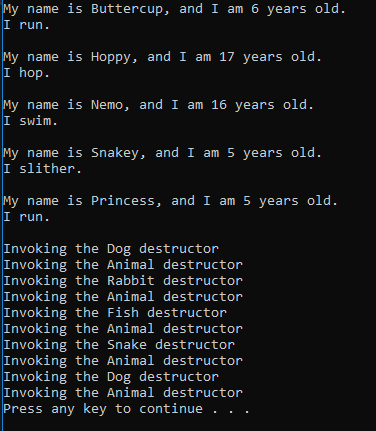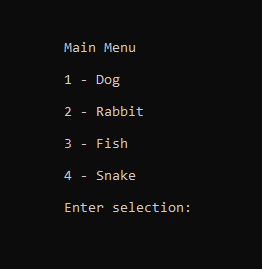Create a base class called Animal. All animals have a name (i.e. “Fido,” “Thumper,” “Princess,” “Nemo,” etc.) and an age. Provide a default constructor that initializes the age to zero and outputs the message “Invoking the default Animal constructor” and another constructor that allows the name and age to be set by the client. This other constructor should also output the message “Invoking the 2-argument Animal constructor.” Also construct a destructor for this class that outputs the message “Invoking the default Animal destructor.” Your Animal class should have a function called Move that cannot be implemented. That is, it should be declared as a purely virtual function. Your class should also have Get and Set methods to allow the name and age to be accessed. From the Animal class, derive Dog, Rabbit, Fish, and Snake classes. The derived classes should each have constructors and destructors that output an appropriate message (e.g., the Dog constructor outputs “Invoking Dog constructor,” and the Dog destructor outputs “Invoking Dog destructor”)[LS1] .[GM(fCD2] The constructor of each derived class should allow the name and age of the Animal to be set (think member initialization list). The derived classes should each have a member function called Move that overrides the Animal Move version. Dog Move should output “I run,” Rabbit Move should output “I hop,” Fish Move should output “I swim,” and Snake Move should output “I slither.” Write a main function that uses the Animal and derived classes as needed to do the following. You must perform the actions below in the sequence described (i.e., do not take a shortcut around using dynamic memory allocation/deallocation and virtual methods since they are the whole point of the lab). Use the rand() function to generate a random age between 1 and 20 years. Your program should use a seed value of 100 and set the seed only once. Each animal should have its own randomly generated age. (i.e. Don’t generate one age and use it for all of the animals.) Prompt the user to make an animal selection [e.g. (1) for dog, (2) for rabbit, (3) for fish, and (4) for snake] and to enter a name for the animal. Dynamically create a Dog, Rabbit, Fish, or Snake object (depending on what the user entered) and initialize it with a constructor to which is passed its name and age. Save the object (use an array). Repeat steps a. and b. 4 more times. You do not know what animals the user will select or in what order, so you must figure out how to create and store the appropriate objects. After the user has entered all 5 selections, execute another loop that cycles through the 5 selections and invokes the Move function and also displays the name and age of the animal. If you have done it properly, each of your outputs will correspond to the type of Animal the user selected in the order he or she entered them.
Create a base class called Animal. All animals have a name (i.e. “Fido,” “Thumper,” “Princess,” “Nemo,” etc.) and an age. Provide a default constructor that initializes the age to zero and outputs the message “Invoking the default Animal constructor” and another constructor that allows the name and age to be set by the client. This other constructor should also output the message “Invoking the 2-argument Animal constructor.” Also construct a destructor for this class that outputs the message “Invoking the default Animal destructor.” Your Animal class should have a function called Move that cannot be implemented. That is, it should be declared as a purely virtual function. Your class should also have Get and Set methods to allow the name and age to be accessed. From the Animal class, derive Dog, Rabbit, Fish, and Snake classes. The derived classes should each have constructors and destructors that output an appropriate message (e.g., the Dog constructor outputs “Invoking Dog constructor,” and the Dog destructor outputs “Invoking Dog destructor”)[LS1] .[GM(fCD2] The constructor of each derived class should allow the name and age of the Animal to be set (think member initialization list). The derived classes should each have a member function called Move that overrides the Animal Move version. Dog Move should output “I run,” Rabbit Move should output “I hop,” Fish Move should output “I swim,” and Snake Move should output “I slither.” Write a main function that uses the Animal and derived classes as needed to do the following. You must perform the actions below in the sequence described (i.e., do not take a shortcut around using dynamic memory allocation/deallocation and virtual methods since they are the whole point of the lab). Use the rand() function to generate a random age between 1 and 20 years. Your program should use a seed value of 100 and set the seed only once. Each animal should have its own randomly generated age. (i.e. Don’t generate one age and use it for all of the animals.) Prompt the user to make an animal selection [e.g. (1) for dog, (2) for rabbit, (3) for fish, and (4) for snake] and to enter a name for the animal. Dynamically create a Dog, Rabbit, Fish, or Snake object (depending on what the user entered) and initialize it with a constructor to which is passed its name and age. Save the object (use an array). Repeat steps a. and b. 4 more times. You do not know what animals the user will select or in what order, so you must figure out how to create and store the appropriate objects. After the user has entered all 5 selections, execute another loop that cycles through the 5 selections and invokes the Move function and also displays the name and age of the animal. If you have done it properly, each of your outputs will correspond to the type of Animal the user selected in the order he or she entered them.
Computer Networking: A Top-Down Approach (7th Edition)
7th Edition
ISBN:9780133594140
Author:James Kurose, Keith Ross
Publisher:James Kurose, Keith Ross
Chapter1: Computer Networks And The Internet
Section: Chapter Questions
Problem R1RQ: What is the difference between a host and an end system? List several different types of end...
Related questions
Question
Animal Lab
The objective of this assignment is to give you some practice using inheritance, virtual functions, and polymorphism.
Instructions:
- Create a base class called Animal. All animals have a name (i.e. “Fido,” “Thumper,” “Princess,” “Nemo,” etc.) and an age. Provide a default constructor that initializes the age to zero and outputs the message “Invoking the default Animal constructor” and another constructor that allows the name and age to be set by the client. This other constructor should also output the message “Invoking the 2-argument Animal constructor.” Also construct a destructor for this class that outputs the message “Invoking the default Animal destructor.” Your Animal class should have a function called Move that cannot be implemented. That is, it should be declared as a purely virtual function. Your class should also have Get and Set methods to allow the name and age to be accessed.
- From the Animal class, derive Dog, Rabbit, Fish, and Snake classes. The derived classes should each have constructors and destructors that output an appropriate message (e.g., the Dog constructor outputs “Invoking Dog constructor,” and the Dog destructor outputs “Invoking Dog destructor”)[LS1] .[GM(fCD2] The constructor of each derived class should allow the name and age of the Animal to be set (think member initialization list). The derived classes should each have a member function called Move that overrides the Animal Move version. Dog Move should output “I run,” Rabbit Move should output “I hop,” Fish Move should output “I swim,” and Snake Move should output “I slither.”
- Write a main function that uses the Animal and derived classes as needed to do the following. You must perform the actions below in the sequence described (i.e., do not take a shortcut around using dynamic memory allocation/deallocation and virtual methods since they are the whole point of the lab).
- Use the rand() function to generate a random age between 1 and 20 years. Your program should use a seed value of 100 and set the seed only once. Each animal should have its own randomly generated age. (i.e. Don’t generate one age and use it for all of the animals.)
- Prompt the user to make an animal selection [e.g. (1) for dog, (2) for rabbit, (3) for fish, and (4) for snake] and to enter a name for the animal. Dynamically create a Dog, Rabbit, Fish, or Snake object (depending on what the user entered) and initialize it with a constructor to which is passed its name and age. Save the object (use an array).
- Repeat steps a. and b. 4 more times. You do not know what animals the user will select or in what order, so you must figure out how to create and store the appropriate objects.
- After the user has entered all 5 selections, execute another loop that cycles through the 5 selections and invokes the Move function and also displays the name and age of the animal. If you have done it properly, each of your outputs will correspond to the type of Animal the user selected in the order he or she entered them.
Your input screen should look something like this:
As each animal is selected, you should see messages like the following:
Your final output screen shout look something like this:

Transcribed Image Text:My name is Buttercup, and I am 6 years old.
I run.
My name is Hoppy, and I am 17 years old.
I hop.
My name is Nemo, and I am 16 years old.
I swim.
My name is Snakey, and I am 5 years old.
I slither.
My name is Princess, and I am 5 years old.
I run.
Invoking the Dog destructor
Invoking the Animal destructor
Invoking the Rabbit destructor
Invoking the Animal destructor
Invoking the Fish destructor
Invoking the Animal destructor
Invoking the Snake destructor
Invoking the Animal destructor
Invoking the Dog destructor
Invoking the Animal destructor
Press any key to continue

Transcribed Image Text:Main Menu
1 - Dog
2 - Rabbit
3 - Fish
4 - Snake
Enter selection:
Expert Solution
This question has been solved!
Explore an expertly crafted, step-by-step solution for a thorough understanding of key concepts.
This is a popular solution!
Trending now
This is a popular solution!
Step by step
Solved in 3 steps with 1 images

Recommended textbooks for you

Computer Networking: A Top-Down Approach (7th Edi…
Computer Engineering
ISBN:
9780133594140
Author:
James Kurose, Keith Ross
Publisher:
PEARSON

Computer Organization and Design MIPS Edition, Fi…
Computer Engineering
ISBN:
9780124077263
Author:
David A. Patterson, John L. Hennessy
Publisher:
Elsevier Science

Network+ Guide to Networks (MindTap Course List)
Computer Engineering
ISBN:
9781337569330
Author:
Jill West, Tamara Dean, Jean Andrews
Publisher:
Cengage Learning

Computer Networking: A Top-Down Approach (7th Edi…
Computer Engineering
ISBN:
9780133594140
Author:
James Kurose, Keith Ross
Publisher:
PEARSON

Computer Organization and Design MIPS Edition, Fi…
Computer Engineering
ISBN:
9780124077263
Author:
David A. Patterson, John L. Hennessy
Publisher:
Elsevier Science

Network+ Guide to Networks (MindTap Course List)
Computer Engineering
ISBN:
9781337569330
Author:
Jill West, Tamara Dean, Jean Andrews
Publisher:
Cengage Learning

Concepts of Database Management
Computer Engineering
ISBN:
9781337093422
Author:
Joy L. Starks, Philip J. Pratt, Mary Z. Last
Publisher:
Cengage Learning

Prelude to Programming
Computer Engineering
ISBN:
9780133750423
Author:
VENIT, Stewart
Publisher:
Pearson Education

Sc Business Data Communications and Networking, T…
Computer Engineering
ISBN:
9781119368830
Author:
FITZGERALD
Publisher:
WILEY